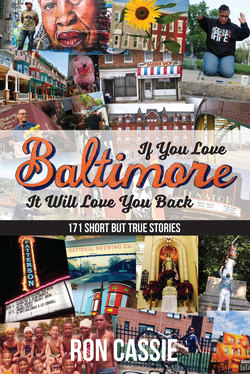Читать книгу If You Love Baltimore, It Will Love You Back - Ron Cassie - Страница 41
ОглавлениеPatterson Park
North Linwood Avenue
June 10, 2013
31. Water Cure
Two-dozen curious environmentalists, taking a bike tour of something described as the Harris Creek Watershed, stop pedaling, and pull up in front of the Patterson Park branch of the Enoch Pratt Free Library. Their tires come to a rest over several large, metal stormwater grates.
They’ve already visited the Real Food Farm on the grounds of Lake Clifton High School, where they were told the watershed’s headwaters begin. They’ve stopped and perused Duncan Street’s Miracle Farm, built on a vacant block in East Baltimore. They’ve ridden south past the Baltimore Recycling Center, Collington Square Park, the Reggie Lewis Memorial Basketball Courts, and bustling but trash-strewn Frank C. Bocek Park.
However, there’s been no sign—visible or otherwise—of Harris Creek.
Not until a whiff of putrid air emanating from the aforementioned storm grates smacks Joy Goodie, atop her bike, square in the nostrils. “Oh, it smells bad,” blurts Goodie, turning her head just before the stench hits everyone else, including her husband and two kids. “It’s repugnant.”
“That’s Harris Creek,” deadpans Leanna Wetmore, program coordinator with Banner Neighborhoods and a tour volunteer with organizer Ben Peterson. Wetmore notes the creek now runs entirely beneath the city, long ago co-opted into the massive underground storm-water system. “The water’s visible if you look down there,” Wetmore adds as a few brave souls take a peek. “When there’s a really big storm, the drains back up and flood this whole area. It can move cars parked here.”
Hard to imagine today, but Maryland Historical Society paintings from the late 1800s actually show boats sailing on the creek through Patterson Park to Canton and the harbor.
Peterson explains to the group—still slightly stunned by the odorous discovery of Harris Creek—that the city’s century-old sewage pipes (some made of wood) run parallel to equally antiquated stormwater pipes. When the outdated sewage lines inevitably bust, raw waste flows into the stormwater lines, entering the harbor untreated. And when thundershowers just as inevitably overwhelm the stormwater system, trash and chemical pollutants from streets, rooftops, and pavement get whisked downstream.
Of course, it’s not just buried Harris Creek that is regularly debased, but the Jones Falls, Gwynns Falls, Middle Branch and Patapsco River, among other harbor tributaries. At the tour’s end, where Harris Creek empties into the harbor, not far from Canton’s Waterfront Park, where residents in days long gone swam and crabbed and local clergy dunked their flock in full-immersion baptisms, frustrated activist Raymond Bahr calls healing the harbor, “mission impossible.”
By coincidence, the morning following the Harris Creek bike tour, the Waterfront Partnership releases the most comprehensive report ever on the harbor’s water quality. The grade: C-. Those who compiled the report, however, admit the harbor was scored on a large curve. The C- indicated that the harbor’s overall water quality was acceptable only 40 percent of the time; a score of 50 would’ve been considered a mid-range “C,” indicating that water quality met acceptable standards on half of the days.
“As it was, in our system, the grade was just percentage points above a D+,” says Baltimore Harbor Waterkeeper Tina Meyers, who assisted in compiling the report card. “If you used high-school grades, it would be F’s all the way from zero to 60 percent.”
